
The artist at his home studio in Dasmarinas, Cavite
Photo Courtesy of: Christiane de la Paz
THE QUINTESSENTIAL ARTIST-STORYTELLER:
EMMANUEL GARIBAY
by: Christiane L. de la Paz
Emmanuel Garibay was born on November 17, 1962 in Kidapawan, North Cotabato by a father who worked as a pastor in a Methodist church and a mother who worked in the city engineer’s office. His family moved to Davao city where he spent a secure and happy childhood. In 1968, then only six, Garibay’s mother provided the earliest significant encouragement for his artistic talent. His work even as a young boy showed a grasp of human character, particularly of soldiers. “Young boys are always fascinated with men in uniform,” he says. “I then went to a phase of doodling robots, tanks, and make-believe characters.”
He recalls with great relish as a child growing in Davao that he was taken in by the awe of owning a bicycle. The bicycle spelled freedom and fun that took him around the neighborhood and the lakes with his friends. The young Garibay would always set off on his bicycle and pedalled up the drive with his friends to explore new places and meet new people. “I love Davao,” he muses, describing it as “charming and wild in so many senses of the word.”
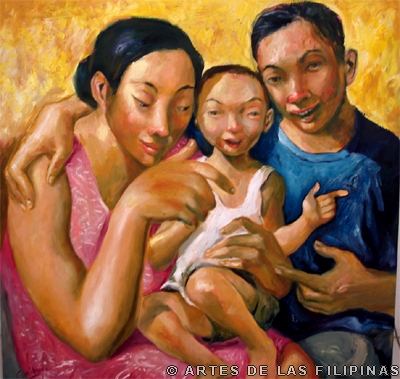
Emmanuel Garibay
“Family Picture”
40 x 40 inches
2005
acrylic on canvas
Davao provided the ideal environment for the young Garibay’s intense aesthetic sense; it was a much visited place by artists, including Victorio Edades (1895-1985), Ang Kiukok (1931-2005), and sculptor Napoleon Abueva. He had begun his schooling in 1968 at the public school, where he was surrounded by fun-loving children of the town, who exemplified camaraderie in his everyday life. He had an inexplicable attraction to the place and was attached to the area by “an invisible umbilical cord,” which could never be cut and forgotten.” He said of his childhood “every house has an old man or woman, a drunken man, a gang of kids roaming around town, and lots of stray dogs.”
In 1979, his elder siblings left for Manila to pursue their college education. Garibay, however, went to pursue his studies in the University of the Philippines in Los Baños, Laguna. Garibay was majoring in sociology, a course, which he jokingly says “i ticked off in my college application form.” The course introduced to him the set of perspectives on human life that allowed him to understand how personal lives are affected by one’s place in society and that the events and experiences in one’s life are part of group dynamics, social institutions, and cultural meanings. This appears to have made a significant impact on him as this was later on to influence his subject matter.
While his heart was not so much in it, Garibay’s artistic studies were more consistent than the rest of his education. When he was a college sophomore, he applied as an illustrator for the university’s community newspaper, Perspective, where he met Edna Jaococo, a beautiful Chinese mestiza from the nearby town, who was majoring in veterinary medicine and whom he courted for two years and eventually married. It was in this same period when he discovered the joy of painting and soon all interest in sociology was gone.
“In college, I spent an enormous amount of time meeting with other students from UP Diliman,” he shares. “There were times when we skipped class and proceed to Mendiola to rally. We spent our allowances buying canvases and paints and work day in and out to use in our rallies. The students whom I interacted with were using their art to epitomize the suffering and realism of the time. It seemed like it was the natural thing to do; painting these pictures to insert information that was going through our heads. I was also doing sports to balance my student life.”
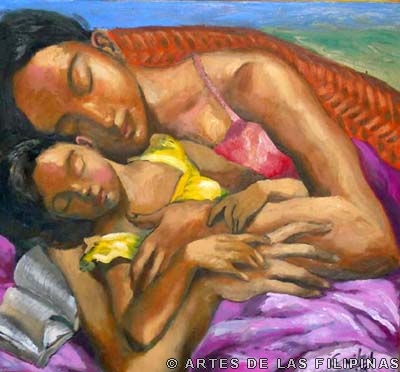
Emmanuel Garibay
“Idlip”
40 x 60 inches
2002
acrylic on canvas
Two years later, the artist moved back to Manila and landed his second job as a tour guide and curator assistant in the Malacañan Palace Museum. In between his work, he steals time to pursue his passion to paint. Garibay made a promise to himself to never abandon his passion regardless of his day job. “I don’t want to forget about painting,” he shares. “I never want to put my talent to waste so I paint in my spare time. I bring materials with me at work to make up for my boring work in the palace.”
In 1985, as he was always far more interested in painting and drawing, Garibay returned to his studies in the University of the Philippines in Diliman to pursue a degree in the Fine Arts to learn the disciplines necessary in order to paint. While Garibay entered the artworld fairly late in his life, he made fast progress once he was in it. He became aware of the avant-garde trends of figurative expressionism where artists combined phantasmagoric visions with psychological insight: James Ensor (Belgian, 1860-1949), Oskar Kokoschka (Austrian 1886-1980), Elaine de Kooning (American, 1918-1929), Robert Beauchamp (American, 1923-1995) and those who delved darkly and mordantly into the grotesque such as Goya and Bosch. While he turned to avant-garde themes and styles, his early works were of traditional subjects. It was clear that even at his student days, Garibay was already exhibiting that strange mixture of conservatism and radicalism that characterized his artistic career. At the age of 24, he was set to make a career in painting.
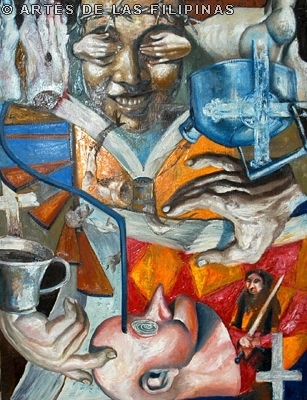
Emmanuel Garibay
“Untitled”
20 x 30 inches
2004
acrylic on canvas
Garibay’s career as a visual artist was not exactly on fire after graduating from Fine Arts — even though it had percolated with a lot of promise from nearly the beginning. For a period of three years, beginning in 1990, Garibay went through an artistic crisis. Like many of his peers, he was without a gallery and his earlier paintings had gone unsold. Garibay fondly tells his first attempt to exhibit: “It was very hard back then,” he recalls. “We approached some galleries but we could not get any kind of clear approval whether they will exhibit us or not.” It was then that I decided to have my first solo exhibit in our house in Fairview with fifteen small-scale paintings to show. It was raining hard that night. Mark (Justiniani), Karen (Flores) came to give their support. Johnny Alcazaren and Bernie Pacquing arrived from Pasig riding their bicycles. They were soaked when they arrived. My wife prepared steamed corn and macaroni soup for everyone. Looking back, I was happy that I was able to pursue my plan to exhibit. That exhibit started the idea for artists to hold their exhibit in series of houses. After that, our next exhibit was in Elmer Borlongan’s house in Nuevo de Pebrero in Mandaluyong.”
Following his introductory sampling, Garibay’s self-directed works emphasized study of the masters. In museums and in book references, he consulted paintings by El Greco, Pablo Picasso, Chaim Soutine, and Bosch. While Garibay admired and studied the works of foreign masters, none even begin to compare to the tremendous impact of Ben Cabrera, Malang, Federico Alcuaz, Angelito Antonio, Danny Dalena, and Nena Saguil upon his works. More important by far are his firsthand observations of other artists’ works: Elmer Borlongan, Ferdie Montemayor, Marcel Antonio, Jason Moss, whose art “takes real and imagined stories as their starting points and allows the complex narratives in their works to evolve.”
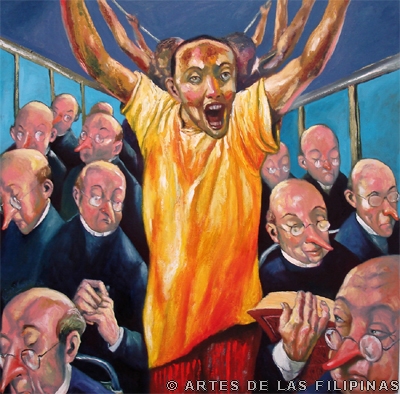
Emmanuel Garibay
“The Righteous Men”
40 x 60 inches
2006
acrylic on canvas
The artist’s uncertainty as an upcoming artist did not last that long. In 1993, Garibay held his first one man exhibition in Liongoren gallery with the collective title “Pasada.” “I never thought I’d break into the art scene. I had so many doubts when I was starting. Some of my works look dirty and the draftsmanship is not clean.”
His first one-man exhibition showed his ability to paint in oil while demonstrating his talent to tell a story in his works. Oil is his favorite medium. It has given his works layers of marks, shapes and forms. “When you look at a painting done in oil, it tells more stories than what you see. If it is handled correctly, oil paintings are pulsating with life. You put a layer of colors after one layer to produce a certain kind of color. Sometimes it may not look that beautiful the first time but the longer you look at it, the more that it grows on you. Oil could have that effect on the viewer.”
Subsequently, Garibay won the Juror’s Choice Award in the same year and received a certificate of merit from the Art Association of the Philippines. Ramon and Lay Ann Orlina bought that piece and acquired two more of my paintings.”
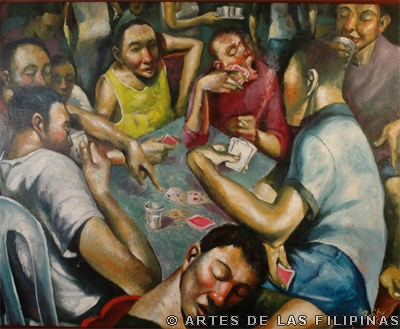
Emmanuel Garibay
“Tong-its Muna”
40 x 60 inches
2005
acrylic on canvas
With his first winning, Garibay slowly began his ascension. This time he approached his work with a new directness and seriousness. He added poignant religious subjects, siege compositions, and figure collages with political themes in his repertoire. His succeeding exhibits were held in several galleries in Manila which include among others, the British Council gallery, Boston gallery, West gallery, and many times over, the Liongoren gallery. In 1994, he visited Spain and competed for II Bienal del Baloncesto en Balles Artes. He placed second in the painting category. The following years, Garibay continued to travel widely in Europe, Asia, and the United States, bringing with his large-scale commissions he received and pieces he entered in several art competitions abroad.
Garibay, in a past interview described the experience, “as having working class type of shoppers who spent time surveying my paintings while others gave my work a sweeping glance and walked on.” While his works did not sell right away, this establishes him as a visual artist of exceptional promise. It demonstrated his preoccupation with the images which he holds dear – the masa.
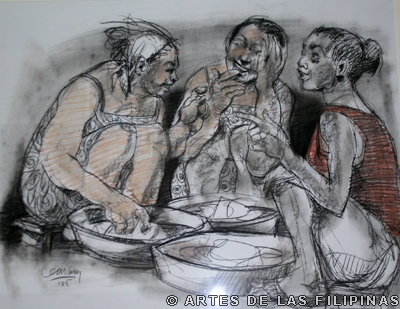
Emmanuel Garibay
“Tsismis”
14 x 16 inches
2005
pastel on paper
Many of Garibay’s paintings focus on everyday people and places. He painted ordinary people in an attempt to portray them as a political entity. In this way Garibay’s activism showed through in his work. He truthfully portrayed ordinary people and places, leaving out the glamour that most Filipino artists added to their works. Garibay says that, “it is the richness of the poor that I am drawn to and which I am part of that I want to impart in my art.” He bemoans that among the things that are central to him is the knowledge of the self– the individual vis-à-vis the community or a collective self-awareness which he feels is lacking in the consciousness of the Filipinos.
For many years, the artist continued to herald the working class in his paintings but in his later works, he began to gravitate towards new kinds of modern subject matters: musicians, harlequins, mother and child, and the family. His palette lightened significantly as he added more objects with brighter colors. “I wait for the right time for me to paint these subjects,” he explains. “I don’t stay long in the same style. I work everyday and the truth is, you don’t feel the same way everyday. When I paint, it’s all about my ideas so even if I paint some sentimental themes, it has to be according to how I would like it to be. It should be the kind of relationship that exists between two persons.”
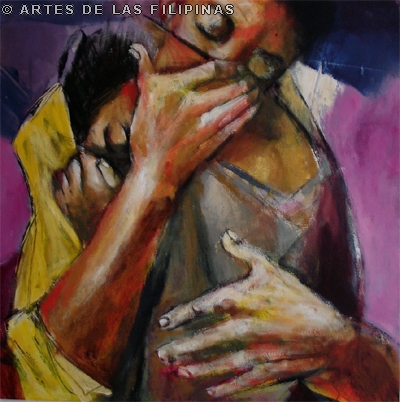
Emmanuel Garibay
“Pagbabalik Loob”
20 x 30 inches
2005
acrylic on canvas
In Pagbabalik Loob (2002), Garibay portrayed a powerful image of a man embracing a child. He allowed the emotion to come forward out of two faces; devoiding the canvas with any other details. It proposed a new paradigm for the presentation of a common theme but of particular value to viewers but thoroughly accessible and of real interest to a casual observer. Garibay often played games with scale by employing enormous precision to depict a feature at a great distance, he does this very well in his emphasis with the hands of his subjects. Garibay’s execution of hands is both symbolic and expressive. Like the great master sculptor, Auguste Rodin, Garibay saw the hands as able to express the emotions of the entire body. Hands become important tools of expressions and are points of connection and passing between people.
Drawn by the many possibilities of his personal experiences and his environment, Garibay is also fascinated with depicting crowds in his paintings. He seemed to have something of a love-hate relationship with this subject, for he once said that “crowds are one of the more interesting images for me to paint but I hate crowds. I hate being in crowded and suffocating places. Sometimes, I merged with the flow of crowds when I go to the market as it serves as a good source of images for me. I go to the market without the thought of buying something but just to observe and be with the crowd.”
With a showmanship that is almost always flamboyant and sometimes controversial, humor informs many of the most interesting works of Garibay. Perhaps a good example is “The Bishop Takes A Bow.” With the idea that beasts, vipers, and monsters descend upon mild-mannered men; a bishop is shown garb in white tunic and deep red himation; while a head of the giant, sinuous snake hovers overhead. The artist deliberately used harsh, garish and violent colors to embody the wildness of his subjects and other menacing creatures reminiscent of those in Francisco de Goya’s The Sleep of Reason Produces Monsters.

Emmanuel Garibay
“Sagrada Familia”
30 x 30 inches
2002
pastel on paper
A different kind of story is presented in Sagrada Familia (2000) with the haloed Joseph in crowning thorns in the company of Mary and the little boy Jesus pinching his mother’s left nipple. The artist offers food for thought as well as curiosity to those who view this work. Why is the Holy Family naked inside a jeepney in the modern world? There was nothing casual about the composition, nothing at all. Garibay created a thought-provoking composition that tears apart the construction of family. The spiritual atmosphere that the subjects deserve was lifted from the clichés of parenthood: the over-protective father and the self-sacrificing mother. This time he took the subject out of their context and experimented with the subject’s form, gesture, and expression. This piece is kept from the sentimentality inherent in his other works and perhaps be best explained by an analysis of the artist’s early life, in which traditional Filipino values vied with the influence of radical modern ideas. Garibay produced many pieces in this manner.

Emmanuel Garibay
“Inang Maria”
40 x 40 inches
2003
acrylic on canvas
Garibay has been attacked as an artist who uses his political skills to foster non-threatening humor to preach in his works. “I always preach in my paintings. That’s intentional because I’m trying to impart ideas but I try not to be preachy in terms of its appearance. I want the ideas to get across in a more subtle way. If it becomes direct then that becomes propaganda and it’ll be in bad taste. Art is all about a piece of idea that you want to share, a way of seeing the world that you want people to be appreciative of their world.”
“Once you become an artist you’d know how it feels to be God– to create something out of nothing,” he adds. At first you look at a blank canvas and suddenly its build up with life. When I don’t feel like painting, I just sit infront of the painting. If I stare at the canvas long enough, it’s like wrestling with the canvas. I have a very competitive mentality so I don’t want the canvas to win over me.”

Emmanuel Garibay
“Back Itch”
14 x 16 inches
2003
pastel on paper
As an artist, Garibay believes that skills are developed as one pursues his passion. He explains that “skills become the inevitable consequence of one’s passion. All forms of art have to have a high degree of craftsmanship. The quality of the craftsmanship will categorize your work as an art form. Hindi puede yung bara-bara na lang then sasabihin mong art yon. That’s why I always insist on passion kasi something that you do over the years will inevitably be of high level of craftsmanship in time.”

Emmanuel Garibay
“Gabriela”
30 x 40 inches
2006
pastel on paper
In 2002, the Cultural Center of the Philippines recognized his talents, achievements, and contributions and was honored the Thirteen Artist award for visual arts. From then on, Garibay’s art has become a masculine art: unfussy, brusque, direct. They all chose to explore the truth of what he saw but not a single one lacks beauty or dignity.

Emmanuel Garibay
“Biyahe”
36 x 48 inches
2004
acrylic on canvas
Emmanuel Garibay is more than just the thinker and artist of the working class. He remains a cultural icon in Philippine art, revered and loved by those who knew him or who met him in a game of basketball or chess or just roaming around the market. Even though he was in many respects an educated activist, he retained the warmth, common touch, humor and manners of the working class people he had grown up with and who he loved and mixed with daily. Emmanuel Garibay remained truly and deeply loyal to the plebeian culture that had spawned him, his politics, religion, and his art.

Emmanuel Garibay
“The Bishop Takes A Bow”
20 x 20 inches
2002
acrylic on canvas

Emmanuel Garibay
“Waiting for Someone”
30 x 30 inches
2005
acrylic on canvas










